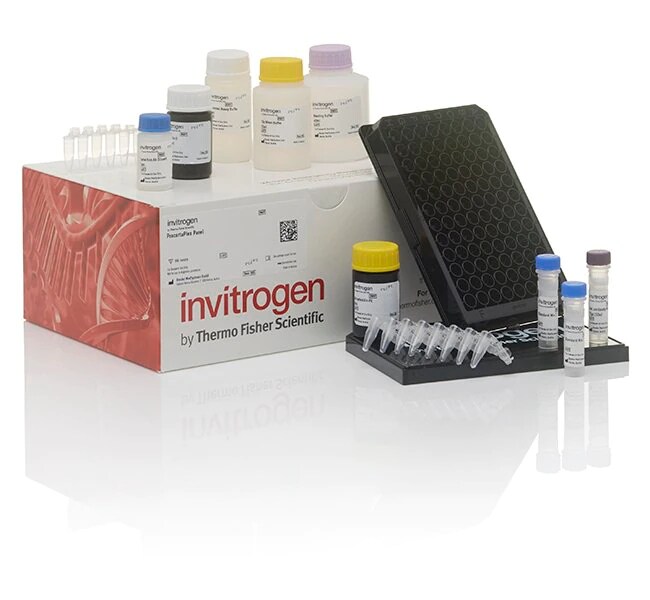
The ProcartaPlex Human Cell Death Panel 4plex enables cancer research by analyzing four protein targets involved in cell death using Luminex xMAP technology. Many different types of regulated cell death have recently been described in addition to apoptosis and necroptosis, namely pyroptosis, parthanatos, autophagy, ferroptosis, netosis, and immunogenic cell death, underlining the importance of resisting cell death as a hallmark of cancer.
This panel contains prominent marker proteins involved in cell death. Danger-associated molecular patterns (DAMPs) are released upon cell stress (HSP70, HSP90) and play an important role in the development of cancer, as well as the response to anti-cancer therapy and immunogenic cell death (HMGB1). In addition, DKK1 is included in the panel, which is a secreted protein that regulates cell survival via the WNT signaling pathway.
The panel is provided in a ready-to-use format with individual vials of capture and detection reagents formulated at 1X concentration, requiring less pipetting and experimental setup. It is not combinable with simplexes or other panels. The biomarkers in this panel complement those in the Human Apoptotic Cell Clearance Panel 12plex targeting soluble proteins in serum and plasma and the Human Apoptosis Panel 6plex targeting proteins in cell lysates.
ProcartaPlex preconfigured panels are extensively tested for analyte combinability, interference, and cross-reactivity to provide the highest level of validation and precision. ProcartaPlex multiplex panels are available in multiple formats across six species (human, mouse, rat, nonhuman primate, porcine, and canine) and are supplied with the necessary reagents to perform the assay. Visit our ProcartaPlex Immunoassays page for more information and available products.
Target list [bead region]: Dkk-1 [27], HMGB1 (HMG-1) [51] HSP70 [29], HSP90 [56]
About ProcartaPlex assays for the Luminex platform
ProcartaPlex immunoassays are based on the principles of a sandwich ELISA, using two highly specific antibodies binding to different epitopes of one protein to quantitate all protein targets simultaneously using a Luminex instrument. ProcartaPlex multiplex assays require as little as 25 μL of plasma or serum, or 50 μL of cell culture supernatant, and just four hours to obtain analyzed results.
• Reproducible, reliable results—validated as a panel to the highest industry standard, including protein target combinability and cross-reactivity testing
• More results per sample—measure multiple protein targets simultaneously in a single 25–50 μL sample
• Well-established Luminex technology—the most referenced multiplexing platform for protein detection and quantitation
ProcartaPlex assays utilize Luminex xMAP (multianalyte profiling) technology for the simultaneous detection and quantitation of up to 80 protein targets in a single 25–50 μL sample—from plasma, serum, cell culture supernatants, and other bodily fluids.
The Luminex MagPlex superparamagnetic microsphere beads in the ProcartaPlex assay are internally dyed with precise proportions of red and infrared fluorophores to create 100 spectrally unique signatures that can be identified by the Luminex xMAP detec¬tion systems (Luminex 200, FLEXMAP 3D, and MAGPIX systems). Similar to a sandwich ELISA, the ProcartaPlex assay uses matched antibody pairs to identify the protein of interest. In a multiplexed assay, each spectrally unique bead is labeled with antibodies specific for a single target protein, and bound proteins are identified with biotinylated antibodies and streptavidin–R-phycoerythrin (RPE). The conjugation of protein-specific antibodies to a distinct bead allows for analysis of multiple targets in a single well.
The most significant difference between a ProcartaPlex assay and ELISA is that the capture antibody in the ProcartaPlex assay is conjugated to a magnetic bead and not adsorbed to the microplate well, so the ProcartaPlex assay reagents are free-floating in the solution. For detection, the Luminex 200 instrument, for example, contains two lasers, one to distinguish the spectral signature of each bead and the second to quantify the amount of RPE fluorescence, which is proportional to the amount of protein present in the sample. ProcartaPlex multiplex assays can profile more target proteins using significantly less sample in the same time that it takes to perform a traditional sandwich ELISA.
ProcartaPlex multiplex panels are available in multiple formats across six species (human, mouse, rat, nonhuman primate, porcine, and canine). Visit thermofisher.com/procartaplex for more information and available products.
| Code | Description |
|---|---|
| EPX040-15843-901 | Catalog Number: EPX040-15843-901 |

